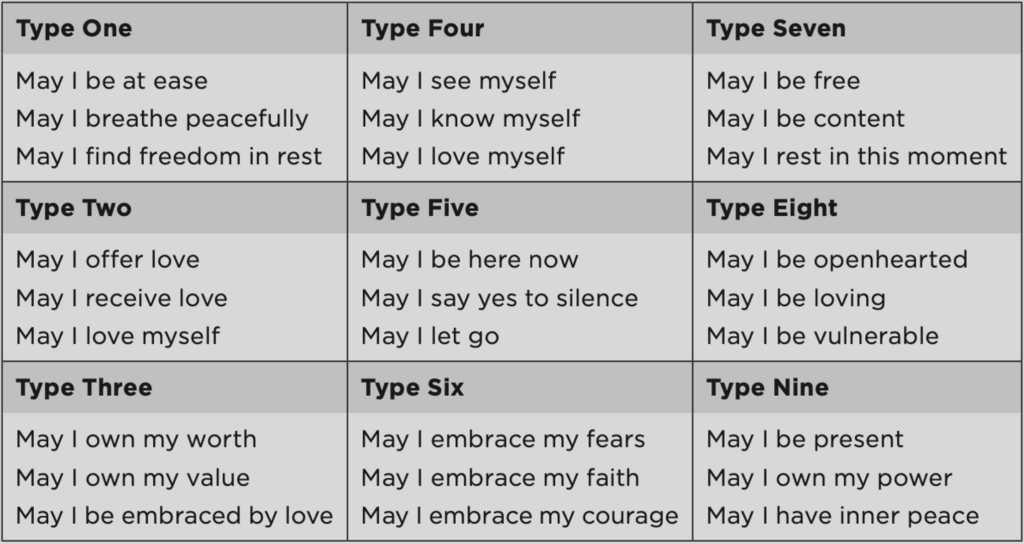Loving Kindness Meditations for Our Enneagram Type


The Loving Kindness meditation is an unconditional, inclusive meditation practice that aids in the development of radical compassion for yourself and others. Called metta bhavana in the Buddhist tradition, this practice may be adapted or used as a tool for coming into greater awareness of our own belovedness. When practicing a Loving Kindness meditation, we’re instructed to dial down the voice of our inner critic, muting her self-criticism and internal commentary.
At the beginning of moving this practice to a discipline, we focus on ourselves first. Then, once we’ve developed compassionate loving kindness (even for the hardest parts of ourselves to accept), we expand the meditation to include the people in our lives.
Let me offer an example of one of the Loving Kindness meditations I frequently practice:
May I be filled with faith.
May I be a source of hope.
May I be aligned with love.
After falling into a natural cadence with these lines and really owning them as intentions for myself, I’m able to include others in successive stages of acceptance through this practice. The subsequent stages of this practice include: (1) those who love me, (2) those I love, (3) those who are difficult for me, and (4) those in my larger community. The meditation evolves into phrases like this:
May you/we be filled with faith.
May you/we be a source of hope.
May you/we be aligned with love.
To develop your own practice is simple:
1. Choose a few affirming statements or phrases that attend to a tender part of your heart.
2. Determine those you intend to include in this practice, those who you hope will also benefit from your mindful loving kindness.
3. Assume a posture that is relaxed while remaining attentive and alert. If you’re able, sit upright in a comfortable chair or with your legs crossed on the ground. Close your eyes or allow your gaze to gently drift to the floor two to three feet in front of you. Draw attention to your breathing and allow it to return you to the present moment every time you get distracted.
4. Begin your practice by repeating your own affirming phrases for three or four minutes. (You may even want to give yourself more time at the outset of habitualizing this meditation.) After a few minutes, begin to affirm these statements for others, offering each successive movement an additional three or four minutes. Ideally you would spend fifteen to twenty minutes with this practice but, depending on your time constraints, you may be able to accomplish these stages in a briefer amount of time.
Similar to all contemplative practices, the fruit of this practice won’t be found in the meditation itself but demonstrated in your active life. The practice transforms our inner critic to a compassionate inner witness or a non-judging inner observer. By activating the “observer” or “witness” function of this aspect of mind, we discover compassionate acceptance of the whole of who we are.
When we can learn radical self-acceptance through this practice, it inevitably leads to more compassionate living with others. This is why the meditation naturally incorporates additional people in the practice.
Once my loving kindness meditation seems to take effect, I sense my heart opening to first make room for myself and then for those in my life who are included in my practice. It usually goes something like this:
1. I practice for myself, including my inner child and my inner critic.
2. I practice for a person who has taught me about self-acceptance and compassion, usually a mentor or teacher (past or present).
3. I practice for a person whom I love and care for deeply (I imagine them sitting with me).
4. When I feel rooted in the loving kindness being generated, I try to practice for a person who is difficult for me, someone who has hurt or betrayed me.
5. I practice for my local community, for my extended community, and for those near and far who are suffering.
When aligning this with our Enneagram type, the practice helps suppress the unwanted voices and thoughts our inner critic and Fixation inflict upon our tenderness and goodness. Let me suggest a type-specific mantra that can be incorporated as a Loving Kindness meditation for each of the nine types.

Excerpt adapted from The Enneagram of Belonging: A Compassionate Journey of Self-Awareness by Christopher L. Heuertz. © 2020 by Christopher L. Heuertz. Published by Zondervan. Used by permission.
This article first first appeared in Enneagram Monthly Issue 258, January 2021 © Christopher Heuertz. Do not reprint or share without permission.
Stay updated on Chris’s latest work and insightful Enneagram writings by subscribing to The Enneagram of Belonging on Substack.
Photo Credit: Unsplash
2 Comments
You must be logged in to post a comment.

Loving-Kindness is a practice of mine that I both practice and teach. I really appreciate the Enneagram-informed wisdom on how this loving-kindness stance can express through each Type lens! Reading mine (Type 3) feels like a balm.
Agreed! I enjoy practicing Loving-Kindness too. Chris does a great job of teaching it through the lens of the Enneagram.